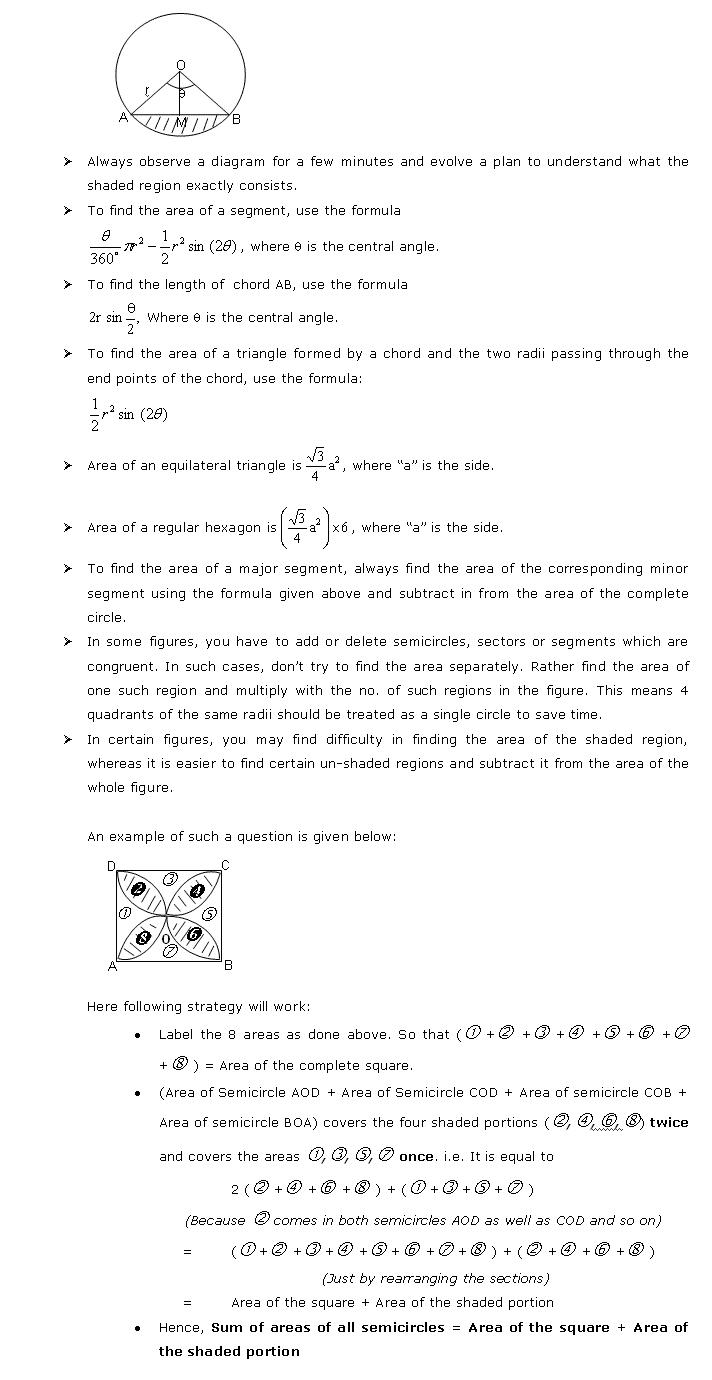|
|
| Help | |
| You are here: Rediff Home » India » Get Ahead » Careers » Education |
|
| |||||||||||||||||||||||
|
| |||||||||||||||||||||||
In yesterday's article, we discussed speed stratgies for Number Systems, Algebra and Geometry covered in the Class X syllabus.
Today, in the second part of speed strategies for mathematics, rediff.com in association with TCYonline.com, looks at certain strategies to help Class X students to attempt questions from the remaining chapters -- mensuration, geometry, trigonometry and statistics and probability.
Mensuration
Most of the times students are asked to find the area or perimeter of a specific region shaded in the given diagram. Students should memorise all the related formulas to apply them according to the context.

Volumes
~ Always draw a diagram of the solid in all types of mensuration problems and write the given information in diagram.
~ Finding the volume of a solid is easy, if you remember the formula. In the case of combinations, you have to find the volumes of the component solids and then add them to find the total volume. Same strategy can be used to find the curved surface area of the combination of solids.
~ If the combination involves solids where p is involved, substitute the value of p at the last stage. Check the question before putting the value of p. Most of the times it is given in the question.
~ In conversion of solids, everything changes except the volume remember the formula
Volume before conversion = Volume after conversion
~ To find the volume of flowing water, use the formula
Volume of flowing water = Area of cross section (of the container) � speed x time
Remember that the volume of flowing water = the volume of the container where it gets collected (up to the height it gets collected).
Surface Areas
Students face problems in deciding as to what all are to be taken to find the total surface area of a solid.
~ To find the total surface area, include all faces which are visible to you. This is the best way to clear your doubts. Apply this principle in the case of combinations.
~ Most importantly, the total surface area of a combination is not equal to sum of the surface areas of the component figures.
~ Students should draw the diagram and visualize the solid in their minds to take a decision about total surface area.
Co-ordinate Geometry
~ To prove that a given set of three points to be collinear always use the area formula and show that it is equal to zero. (unless mentioned otherwise)
~ To prove that a quadrilateral with given vertices is a parallelogram, prove that the diagonals bisect each other. This can be done by finding the mid-points of the two diagonals separately and proving that both are same. Remember that all other methods are lengthy and you are likely to make an error in those.
~ If three vertices of a parallelogram are given and you are asked to find the fourth vertex, again use the fact that both the diagonals have the same mid-point. Here, find the mid point of the diagonal whose vertices are given and use this as the mid-point of the other diagonal. And find the co-ordinates of the fourth point.
~ To prove a quadrilateral to be a rhombus, just prove all the sides are equal.
~ To prove a quadrilateral to be a square, prove that all the sides are equal and the diagonals are equal.
~ To prove a parallelogram to be a rectangle, prove that diagonals are equal.

Statistics & Probability
In statistics, students don't find too many problems as far as they know the relevant formulas. They should practice to convert a cumulative frequency distribution into a frequency distribution. Practice both the types i.e. below the upper limit type and above the lower limit type.
~ To find two missing frequencies in a distribution, remember that you need two equations.
~ Try to find these equations and solve them to get the answer.
In probability, remember that if one trial can have "m" outcomes and another trial can have "n" outcomes then the total number of outcomes, when the two trials are carried simultaneously, is "m x n".
For example, if a coin is tossed three times, the number of total outcomes is 2 x2 x 2 = 8.
Also, total number of outcomes when two dice are drown simultaneously = 6 x 6 = 36.
Beware of questions involving words like at least, at the most, and, or etc.
You should always remember that your focus, presence of mind and courage will decide the result. Use faster, quicker and easier methods to be perfect in Mathematics. Plan your solutions in your mind and then start writing. If you follow the points we discussed about and some others techniques you have been following wisely, you will be able to finish the papers with in two and a half hours giving you enough time to check your work.
One important recommendation
TCYonline.com recommends the Class X students to regularly analyse the types of mistakes committed in the last couple of tests and list out the types of errors you are likely to make. Check for these mistakes in the last 30 minutes to ensure no error is left out.
Part I: Speed strategies in mathematics for class X
|
|
| © 2008 Rediff.com India Limited. All Rights Reserved. Disclaimer | Feedback |